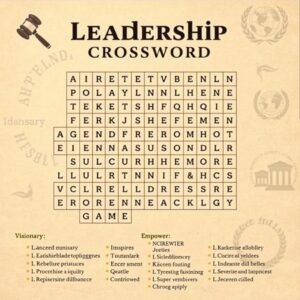
Explore & Play
Discover interesting topics and solve the accompanying crossword puzzle.
Protection crossword | Role of Protection in Our Daily Lives
Table of Contents
You can start by playing the Protection crossword to test your knowledge about various safety tools and measures. If you’re not very familiar with the topic, feel free to read through the article first for a deeper understanding, then come back to the crossword and challenge yourself with the new insights.
Protection Crossword
You can either fill in the crossword puzzle directly on this page or click the button in the bottom right corner to print it for free.

Everyday Tools of Safety: Exploring How We Stay Protected
From the moment we step outside our homes to the security measures we rely on indoors, protection is an integral part of our lives. Whether it’s safeguarding our health, ensuring our personal security, or shielding our digital data, protection surrounds us in various forms.
This article delves into the tools and strategies that help us stay safe daily. We’ll also introduce a crossword puzzle that offers a fun way to explore these concepts while learning how different measures contribute to a secure and healthy life.
The Evolution of Protection
From Fortresses to Helmets: Historical Protection
Protection has been a core concern of humanity since the beginning of time. Early humans sought refuge in caves and natural shelters to escape predators and harsh climates. Over time, these rudimentary shelters evolved into fortified structures like castles, walls, and fortresses. These edifices were not only physical barriers but also symbols of strength, providing communities with a sense of safety and belonging.
Weapons and protective tools were developed alongside these structures. Shields and helmets became essential gear in battles, protecting warriors from arrows and swords. These items, made from materials like wood, leather, and later metal, were designed to deflect harm while allowing mobility.
Religious and cultural aspects also influenced protection methods. For instance, amulets and talismans were used to ward off evil, showcasing a blend of spiritual and practical approaches to safety.
Modern Innovations: From Alarms to Firewalls
With the Industrial Revolution and subsequent technological advances, the concept of protection transformed dramatically. Physical barriers like locks and safes became commonplace in homes and businesses, while the invention of alarms brought a new level of security. Alarm systems evolved to detect intrusions, fires, and other emergencies, ensuring immediate responses to threats.
The digital age introduced an entirely new domain of protection: cybersecurity. Firewalls, antivirus software, and encryption now safeguard our personal data and financial information, echoing the ancient need to protect what matters most. Today’s protection systems combine physical, digital, and psychological measures to create comprehensive safety networks.
Personal Protective Equipment (PPE)
Head-to-Toe Safety: Helmets, Gloves, and Boots
PPE plays a vital role in minimizing risks in workplaces, sports, and everyday activities. Helmets are lifesaving equipment, especially for construction workers, motorcyclists, and athletes. They shield the head from impact, preventing traumatic injuries that can have lifelong consequences.
Similarly, gloves serve a variety of protective functions. In medical settings, they prevent the spread of infections, while in industrial environments, they shield hands from cuts, burns, and hazardous substances. Boots, particularly those with reinforced toes, protect against sharp objects, chemical spills, and extreme temperatures.
Eye and Skin Protection: Goggles, Masks, and Sunscreen
Protective eyewear like goggles is indispensable in fields such as construction, chemistry, and sports. They prevent debris, chemicals, and UV rays from harming the eyes, ensuring clear vision and long-term eye health.
Masks are another critical component of PPE. During pandemics or when working in polluted environments, masks act as barriers against airborne particles, protecting the respiratory system. On the other hand, sunscreen is an often-overlooked but essential form of protection. By blocking harmful UV rays, sunscreen helps prevent sunburns and reduces the risk of skin cancer, especially during prolonged exposure to the sun.
In Vehicles: Seatbelts and Child Seats
Road safety measures also fall under the umbrella of PPE. Seatbelts, a simple yet effective invention, have saved countless lives by reducing the impact of collisions. Child seats, tailored to different age groups, provide extra security for young passengers, ensuring they are safe even in unforeseen situations.
Home Safety Essentials
Lock and Alarm Systems: Keeping Intruders Out
Our homes are sanctuaries, and protecting them is a priority. Locks are the most basic yet crucial form of home security, preventing unauthorized access. Modern locks now integrate technology, such as biometric systems or smart locks controlled via smartphones. These advancements offer convenience without compromising security.
Alarm systems, which can detect movement, glass breaking, or unusual activities, enhance protection by alerting homeowners or authorities in real-time. These systems deter potential intruders and provide peace of mind.
Sprinklers and Fire Safety Measures
Fires pose a significant threat to households and businesses, but modern safety measures have reduced their impact. Sprinkler systems automatically detect and suppress fires before they spread, minimizing damage and giving occupants time to evacuate. Complementary tools like smoke detectors provide early warnings, while fire extinguishers allow quick responses to small-scale fires.
Creating Safe Spaces: Fences and Barriers
Fences and barriers are not just physical boundaries but also critical safety features. They prevent unauthorized access to properties and protect children or pets by keeping them within secure perimeters. Indoors, barriers like baby gates prevent toddlers from accessing dangerous areas, such as staircases or kitchens.
Emergency Supplies and Plans
Home safety isn’t complete without emergency supplies. Flashlights, first-aid kits, and emergency plans ensure households are prepared for power outages, injuries, or natural disasters. Regular drills and clear communication among family members can further enhance readiness for unexpected situations.
By combining these safety essentials, families can create environments where protection is a seamless part of daily life.
Tools for Outdoor and Extreme Conditions
Gear for Wilderness Adventures
Exploring the great outdoors requires specialized tools to ensure safety. Hiking boots with sturdy soles protect feet from rough terrain, while waterproof clothing shields against rain and wind. For climbers, harnesses and carabiners provide the physical security needed to traverse vertical landscapes safely. Backpacks with built-in hydration systems and survival kits, including items like multitools, compasses, and fire starters, prepare adventurers for the unexpected.
In snowy conditions, gear like insulated jackets, gloves, and snow goggles are indispensable. Avalanche beacons are life-saving tools for skiers and snowboarders, allowing rescuers to locate them in emergencies. Similarly, ice picks and crampons are critical for traversing frozen or icy terrains.
Surviving Extreme Environments
In desert climates, sun protection is vital. Hats, sunscreen, and UV-resistant clothing shield against intense heat and harmful rays. Portable water filters or purifiers are essential tools for ensuring access to safe drinking water.
In marine environments, life jackets are fundamental for safety during boating or water sports, while waterproof cases for electronics protect devices from moisture. For deep-sea divers, equipment like oxygen tanks, wetsuits, and dive computers monitor vital parameters and ensure survival under pressure.
Technology Meets Adventure
Innovative technology has brought advancements like GPS devices and satellite phones, which provide navigation and communication in remote locations. Solar-powered chargers ensure that essential devices remain functional even in the absence of traditional power sources. These tools, combined with traditional survival gear, create a comprehensive safety net for those venturing into extreme conditions.
Protection in Health and Wellness
Preventive Measures: Vaccines and Regular Check-Ups
Prevention is a cornerstone of health protection. Vaccines guard against life-threatening diseases by boosting the immune system, creating a protective barrier against infections. Regular medical check-ups, including screenings for conditions like diabetes, cancer, and heart disease, allow for early detection and treatment, significantly improving outcomes.
Hygiene and Sanitation Practices
Hygiene is fundamental for protecting health. Handwashing with soap and water, sanitizing surfaces, and proper food handling prevent the spread of bacteria and viruses. Access to clean water and sanitation facilities is critical, particularly in underdeveloped regions, to safeguard against diseases like cholera and dysentery.
Protecting Mental Wellness
Mental health is as important as physical health. Practices such as mindfulness, therapy, and stress management techniques protect individuals from the adverse effects of anxiety and depression. Access to mental health resources, including counseling and support groups, fosters resilience and well-being.
Fitness and Nutrition as Shields
Exercise strengthens the body, reducing vulnerability to illnesses. Similarly, a balanced diet rich in vitamins, minerals, and antioxidants boosts the immune system. Supplements, when used responsibly, can fill dietary gaps, enhancing overall protection against diseases.
Structural and Digital Security
Reinforcing Buildings Against Natural Disasters
Structural security begins with resilient construction. Earthquake-resistant buildings use flexible materials and designs that absorb seismic energy, minimizing damage. In hurricane-prone areas, reinforced windows and storm shelters protect occupants from extreme winds and flying debris. Similarly, flood barriers and elevated construction methods defend properties from rising waters.
Smart home systems integrate sensors that monitor and control environmental conditions. For instance, temperature sensors can detect freezing conditions that may cause pipes to burst, while motion detectors enhance security against intrusions.
Safeguarding Data and Cyber Assets
In the digital age, cybersecurity is an essential form of protection. Firewalls act as barriers that prevent unauthorized access to networks, while encryption secures sensitive information during transmission. Multi-factor authentication and strong, regularly updated passwords provide an additional layer of defense against cyber threats.
Antivirus software identifies and neutralizes malware, ensuring that computers and devices remain functional and secure. Regular updates and patches for operating systems and applications address vulnerabilities, preventing exploitation by hackers.
The Role of Ethical Hacking
Ethical hackers, also known as penetration testers, are professionals who simulate cyberattacks to identify weaknesses in a system. Their work helps organizations fortify their digital defenses, protecting customer data and proprietary information.
Balancing Privacy and Protection
Modern security systems often collect vast amounts of data, raising concerns about privacy. Balancing these aspects is critical to ensuring that protective measures do not infringe on individual freedoms. Privacy-focused solutions, such as end-to-end encryption, help maintain this equilibrium while providing robust security.
Through a combination of structural innovations and digital safeguards, individuals and organizations can create environments that are both safe and secure in an ever-changing world.
Support and Recovery Tools
Emergency Medical Equipment
Support and recovery tools are critical in times of crisis or post-incident recovery. In medical emergencies, tools like first-aid kits play a pivotal role. A well-stocked first-aid kit includes essentials such as bandages, antiseptic wipes, pain relievers, and medical tape. Automated External Defibrillators (AEDs), now common in public spaces, can save lives during cardiac emergencies by restoring a normal heart rhythm.
Stretchers and immobilization devices are crucial for transporting injured individuals safely. For those with chronic conditions, tools like insulin delivery systems, inhalers, and blood pressure monitors enable quick responses to health challenges.
Emotional and Psychological Support
After traumatic events, emotional and psychological recovery is just as important as physical healing. Counseling and therapy provide structured environments for individuals to process their experiences. Support groups create a sense of community, helping people navigate shared challenges.
Apps and digital tools focused on mental health are becoming increasingly popular. Meditation apps, cognitive behavioral therapy (CBT) programs, and virtual therapy sessions make support more accessible, particularly for those in remote locations.
Rebuilding After Natural Disasters
Natural disasters often leave significant physical and emotional scars. Tools for recovery, such as temporary shelters, portable generators, and water purification systems, provide immediate relief to affected communities. Long-term solutions like rebuilding programs, disaster insurance, and community resilience training help individuals and families recover and prepare for future risks.
Training and Education
Recovery often involves learning new skills to adapt to changed circumstances. CPR training, disaster response workshops, and courses on using emergency tools empower individuals to act effectively during crises. These educational resources are tools in themselves, fostering confidence and preparedness.
Creating Your Personal Safety Net
Financial Safeguards
A strong personal safety net begins with financial security. Emergency savings accounts act as a buffer against unexpected expenses, such as medical bills, home repairs, or job loss. Insurance, whether health, home, or auto, is another critical component, providing financial relief in times of need.
Investing in diverse financial products, such as mutual funds or bonds, can also strengthen your safety net. These investments offer long-term growth while serving as a resource during emergencies.
Community and Social Support
No safety net is complete without community and social connections. Trusted neighbors, friends, and family members can provide support during challenging times. Building relationships within local communities enhances access to resources like shared childcare, neighborhood watch programs, or collective emergency planning.
Volunteer organizations and non-profits also play a role, offering everything from disaster relief to food assistance. Knowing which organizations to turn to in times of need is an essential part of creating a reliable safety net.
Personal Safety Plans
A personal safety plan outlines steps to take in various emergencies. This could include knowing evacuation routes, creating a family communication plan, or setting up a designated meeting point. In homes, having an easily accessible go-bag with essentials like water, food, medications, and identification documents ensures readiness for sudden evacuations.
Technology for Safety
Technology is a vital tool for modern safety nets. Mobile apps that track severe weather, provide first-aid instructions, or allow instant SOS alerts ensure that help is always within reach. Smart home systems with features like smoke detectors, security cameras, and remote monitoring enhance personal safety in daily life.
Physical and Mental Resilience
Building a personal safety net isn’t only about tools and plans—it’s also about fostering resilience. Regular exercise, a balanced diet, and stress management techniques like yoga or mindfulness build the physical and mental strength needed to face adversity.
Through careful planning, resource allocation, and self-awareness, a personal safety net becomes a robust framework for navigating life’s uncertainties, offering peace of mind and confidence in the face of challenges.
Safeguarding Today and Tomorrow
Protection is more than a necessity—it’s a shared responsibility that evolves with time. From ancient shields to digital firewalls, the tools we use reflect our commitment to safety. By understanding and utilizing these measures, we create a safer world for ourselves and future generations.
Ready to put your knowledge of protection to the test? Challenge yourself with our crossword puzzle and explore these concepts in an interactive way!
Share to...
I hope you enjoy the content.
Want to receive our daily crossword puzzle or article? Subscribe!
You may also be interested in
Share to…
Want to receive our daily crossword puzzle?
-
Jigsaw Puzzles
Whimsical Garden Cat Jigsaw Puzzle 250 | 300 | 500 Pieces
kr 348,00 – kr 439,00Price range: kr 348,00 through kr 439,00 Select options This product has multiple variants. The options may be chosen on the product page -
Jigsaw Puzzles
Elegant Pig Zodiac Watercolor Jigsaw Puzzle 250 | 300 | 500 Brikker
kr 348,00 – kr 439,00Price range: kr 348,00 through kr 439,00 Select options This product has multiple variants. The options may be chosen on the product page -
Jigsaw Puzzles
Maine Coon Cat Ink Wash Puzzle 250 | 300 | 500 Pieces
kr 348,00 – kr 439,00Price range: kr 348,00 through kr 439,00 Select options This product has multiple variants. The options may be chosen on the product page

















